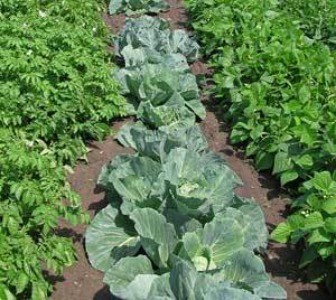
One of the best ways to maximize vegetable garden production, while minimizing problems with pests and disease is by practicing crop rotation-planting your crops in a different place in the garden each year. Rotating your crops is easy. All it requires is dividing your garden into sections, keeping a few planting notes and knowing which of your garden vegetables are closely related.
Reduced Pest & Disease Problems: Vegetable crops benefit from a rotation schedule in several ways. Related crops tend to be prone to similar problems with insects and disease. By moving them to a new location each year, you will reduce the potential for soil-borne pests and diseases to become established in certain areas of the garden.
Efficient Use of Nutrients: Different species of crops also take up varying amounts of soil nutrients at different depths depending on their root systems. Therefore growing a number of different crops in a specific location over time utilizes the soil most efficiently.
Consistent Soil Treatments: Related crops often have similar growing requirements (e.g. pH, fertilizer, etc. ). When crops are rotated, those with similar requirements are grown together when possible. This increases the chances that they have the best possible growing conditions and means that over time, the entire growing area received the same soil treatments.
Long Term Weed Control: Low-growing crops like cabbage and lettuce are good at suppressing weeds due to their large, dense leaves. For crops with slight leaves, like onions and carrots, weed control can be more of a problem. Rotating crops with different growth habits can help control weeds and save you labor over time.
Most crop rotation plans are based on a cycle of 3 to 4 years. This means that every 3 to 4 years, a crop is planted in the same site it started in. If your soil persistently harbors diseases or pests and you have the room, extend the rotation cycle out to 5-6 years.
List Your Vegetables By Family Group: Start by listing the types and quantities of vegetables you want to grow next season. If possible, crops should not be planted where any of their relatives grew the previous year. To avoid this, it's helpful to group vegetables together by botanical family. For example; peppers, tomatoes and eggplants are all related and should be planted and rotated together as a family. Here is a list of common vegetables families and their members:
After you group your vegetables into families, draw a diagram of your garden and divide it into an equal number of sections-one for each year in your planned rotation cycle (e.g. 3 sections = 3 years). Label the sections in the diagram from 1 to 3 and work out which crops will go in each section. If possible, vegetables from the same family should be planted together. If you have to plant more than one crop in an area, try to plant crops with similar growing requirements together.
It will be difficult to rotate your crops each year if you can't remember where you planted them last year. Keep things simple by jotting down where you plant things each year, recording what you add to the soil and keeping track of how well your plans work out.
Year One
In plot #1, prepare the soil in this area by adding a moderate amount of balanced organic fertilizer. Plant root vegetables from the Carrot, Beet or Lily families (carrots, celery, garlic, turnips and onions).
In plot #2, prepare the soil by adding lots of compost or well-rotted manure. In this plot plant crops from the Pea, Squash, Tomato and Lettuce families (e.g. beans, corn, lettuce, spinach, peas, squash, cucumbers, peppers, eggplant and tomatoes).
In plot #3, prepare the soil by adding a balanced organic fertilizer plus compost or well-rotted manure. Plant members of the Cabbage family (broccoli, cabbage, Brussels sprouts, cauliflower and radishes).
Year Two & Three
Rotate the crops from plot #1 to plot #2, the crops from, plot #2 to plot #3 and the crops from plot #3 to plot #1. Continue this annual rotation where each crop moves to the next plot over.

About The Author: Ellen Brown is our Green Living and Gardening Expert. Ellen Brown is an environmental writer and photographer and the owner of Sustainable Media, an environmental media company that specializes in helping businesses and organizations promote eco-friendly products and services.
Add your voice! Click below to comment. ThriftyFun is powered by your wisdom!